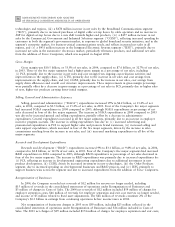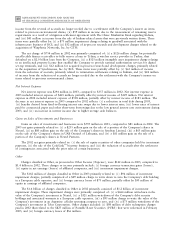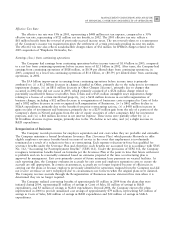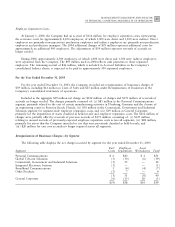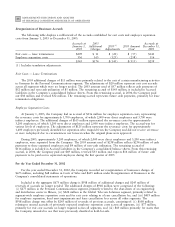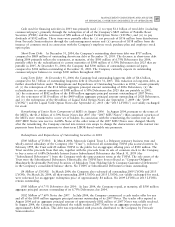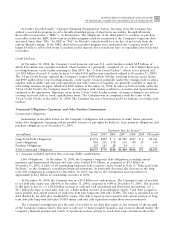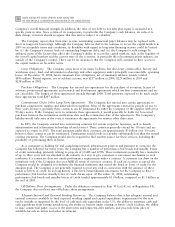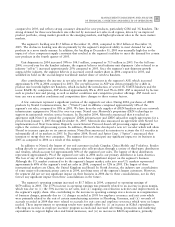Motorola 2004 Annual Report Download - page 54
Download and view the complete annual report
Please find page 54 of the 2004 Motorola annual report below. You can navigate through the pages in the report by either clicking on the pages listed below, or by using the keyword search tool below to find specific information within the annual report.
46 MANAGEMENT'S DISCUSSION AND ANALYSIS
OF FINANCIAL CONDITION AND RESULTS OF OPERATIONS
Liquidity and Capital Resources
As highlighted in the Consolidated Statements of Cash Flows, the Company's liquidity and available capital
resources are impacted by four key components: (i) current cash and cash equivalents, (ii) operating activities,
(iii) investing activities, and (iv) Ñnancing activities. Each of these components is discussed below.
Cash and Cash Equivalents
During 2004, the Company's cash and cash equivalents (which are highly-liquid investments with an original
maturity of three months or less) increased by $2.8 billion to $10.6 billion at December 31, 2004, compared to
$7.8 billion at December 31, 2003. At December 31, 2004, $3.8 billion of this amount was held in the U.S. and
$6.8 billion was held by the Company or its subsidiaries in other countries. Repatriation of some of the funds in
other countries could be subject to delay and could have potential adverse tax consequences.
In light of recently-passed tax laws, the Company expects to repatriate cash during 2005, to the extent the
repatriation is consistent with business strategy and is economically advantageous. However, the Company has not
yet completed its evaluation of the eÅect of the new tax law on its plans for reinvestment or repatriation of foreign
earnings. The Company will evaluate its repatriation plans and the impact of the new tax provision throughout
2005 and will report the repatriation provision eÅect on Ñnancial results in the period the repatriation plan or plans
are deÑned and approved.
Operating Activities
The Company has generated positive cash Öow from operations in each of the last 4 years. The cash provided
by operating activities in 2004 was $3.1 billion, compared to $2.0 billion in 2003 and $1.2 billion in 2002. The
primary contributors to cash Öow from operations in 2004 were: (i) earnings from continuing operations (adjusted
for non-cash items) of $3.0 billion, and (ii) a net increase of $1.9 billion in accounts payable and accrued
liabilities, primarily attributed to increases in accounts payable, employee incentive program accruals, customer
incentive reserves and warranty reserves. These positive contributors to cash Öow were partially oÅset by: (i) an
$808 million increase in other current assets, (ii) a $539 million increase in accounts receivable, (iii) a $433 million
increase in inventories, and (iv) a $68 million increase in other net operating assets.
Accounts Receivable: The Company's net accounts receivable were $4.5 billion at December 31, 2004,
compared to $3.8 billion at December 31, 2003. The Company's days sales outstanding (""DSO''), excluding net
long-term receivables, were 44.9 days at December 31, 2004, compared to 49.1 days at December 31, 2003. The
decline in DSO reÖects the continuing improvement in receivables management across the Company. The other key
factor in the reduction of the overall DSO was the reduction in accounts receivable balance and DSO by the Global
Telecom Solutions segment (""GTSS'') in 2004 compared to 2003, primarily due to an improvement in achieving
payment milestones in Asia. The increase in net accounts receivable was primarily due to the increase in net sales in
the fourth quarter of 2004, compared to net sales in the fourth quarter of 2003, primarily in the Personal
Communications segment (""PCS'').
Inventory: The Company's net inventory was $2.5 billion at December 31, 2004, compared to $2.1 billion at
December 31, 2003. The increase in the net inventory balance reÖects increased net inventory balances in each of
the Company's Ñve major segments. The increase in the overall net inventory balance was primarily due to increases
by: (i) PCS, primarily due to higher levels of components on hand due to the anticipated increase in net sales in
the Ñrst quarter of 2005 compared to the Ñrst quarter of 2004, (ii) the Broadband Communications segment
(""BCS''), due to anticipated increased demand in 2005 compared to 2004, (iii) the Integrated Electronic Systems
segment (""IESS''), due to anticipated increased demand in 2005 compared to 2004 and the acquisition of Force
Computers, and (iv) GTSS, due primarily to anticipated increased demand in 2005 compared to 2004. The
Company's inventory turns increased to 8.9 at December 31, 2004, compared to 7.6 at December 31, 2003. The
increase in overall inventory turns was driven by the increase in turns by PCS, primarily due to the signiÑcant
growth in net sales and eÅective inventory management programs, and is evidence of beneÑts from the continued
focus on inventory and supply chain management process throughout the Company. Inventory management
continues to be an area of focus as the Company balances the need to maintain strategic inventory levels to ensure
competitive delivery performance to its customers against the risk of inventory obsolescence due to rapidly changing
technology and customer spending requirements.


